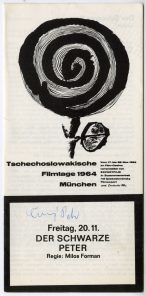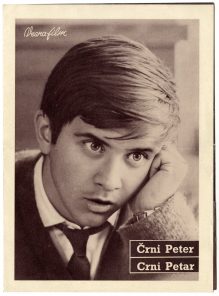Few would dispute the assertion that Forman’s debut feature film, Black Peter (Černý Petr, 1963), endorsed by the critics as well as a majority of viewers, contributed to the tradition of Czechoslovak film canon. However, for contemporary scholars, this might pose a certain occupational risk. With a film so critically acclaimed and widely studied, is it even possible to bring something new to the table? Can it be stripped of myths, without having to succumb to autotelic iconoclasm? And to what extent is it suitable to question the established interpretations while avoiding a historical view or blind trend following? In the case of Forman’s film, the answer to all three questions could be found by a general contemplation on what lies behind the celebrated veristic method, and whether its effects reach beyond the illusions of the real, the true or the authentic.
As for Forman’s early work, Black Peter not excluded, we have comfortably nestled them in such traditional categories as “Czechoslovak New Wave” – “verism” – “sociological research of socialist reality”. Without necessarily having to disparage these labels across the board, a wider outlook from the perspective of European film modernism presents itself. The realistic style of Black Peter, creating a typical illusion of an unrefined depiction of reality, actually does not stem from innocent observation or spontaneous improvisation, but rather from a concrete method of stylization. This approach generally followed two main sources of inspiration – socially engaged (post)neorealism and the observational documentary or cinéma vérité.[1] In Forman’s interpretation, however, it is variously shaded, revealing the heritage of local cultural tradition. Today, carefully mapped stylistic elements of new waves (fragmented observations of everyday life, an open narrative structure, the intensive engagement of non-actors, shooting in a realistic setting, etc.) merge with a grotesque “culture of popular laughter”, refreshing the picture with an original touch; particularly this synthesis characterizes Forman’s work even in the context of period cinematic trends.
The status of a pioneer work of the “comedy of embarrassment”, which became a trademark of the creative trio Forman-Passer-Papoušek, should not overshadow the fact that Forman’s emphasis on shallow folksiness indirectly reflects a grotesque world view, usually connected with the work of the author Jaroslav Hašek. Even though Forman’s farcical comedy compared with Hašek’s caricaturish satire is not altogether the same cup of tea, and Švejk’s witty remarks are nowhere to be found,[2] the affinity between their works is found in their method used to capture the inability to break away from provincialism. For both authors, the comical effect arises from the conflict between pride in a limited value system and the inability to abide by these principles: while Hašek uses this hypocrisy as an effective yet consciously exaggerated survival tool, Forman sees it as a dead-end road. The last scene from Black Peter duly illustrates this issue: the protagonist’s father (Jan Vostrčil), the epitome of a provincial figure of a hearty authoritarian, is giving his son one of many educational lessons, when suddenly he pauses during an expressive gesture, unable to finish his thought. Characters try hard to adjust to the rules of the microcosm in which they live, but as soon as confronted by any change, which extends beyond their limited horizon, they find themselves unable to react quickly, ending up in a vicious circle. This vision, radically different from the universal feeling of alienation found in contemporary works of western European new waves, provides Black Peter, in the context of film modernism, with a specific and distinct gleam.
The strongest means of asserting and embracing a given style of humor is language, specifically the material and spatial quality of speech. A. J. Liehm noted the manner in which Black Peter exercises the method of speech decomposition, considered up to that point to be solely a domain of the theatre of the absurd.[3] The dialogues, which appear to the audience as expressions of genuine sincerity and authenticity, are actually products of well-deliberated wording, with the aim of causing flowing speech to “stutter”, which in turn reveals the eternal absurdity of characters stuck in unchanging mental schemes. The movie revolves around set social rituals with precisely defined rules of conduct (work at the store, family lunch, free time outdoors, dance ball), which by the means of language deconstruction uncover their ridiculous affectation. Protagonists are attempting to abide by the social rules of conduct, or they are guided to do so at least, but they tend to get stuck constantly. A perfect example of this paradox is the famous “Ahój” scene, in which the young man, Čenda (Vladimír Pucholt), repeats a greeting to the point of extreme awkwardness: the protagonist insists on an absurdly exaggerated convention of “correct” greeting to the extent of losing its social function and becoming an object of ridicule. In the case of the father’s pep lectures (rather than talks), the grotesque lowering of official social rules progresses into an almost ideologically subversive role. The chaotic and disjointed flow of words, used by the patriarch Vostrčil to preach to the silent Peter about man’s duties, unwittingly reveals that his position of authority rests on a shaky and uncertain foundation – and as shown in the final stop-shot, such a foundation can collapse in a heap at any time.
The grotesque use of speech would not, however, be as effective, if it were not marked by the hard-earned achievements of modernist cinematography (its naturalist variant) and the European new-wave movement. Forman’s (respectively Passer’s and Papoušek’s) language humor bases its effectiveness on the impression that it is taking place in a live, open and physically pulsating reality, paradoxically facilitated by an aptly selected stylistic manipulation. Pucholt’s acting would not have had such a comical impact if it were not for his impetuous lecturing being accompanied by clumsy gestures amid a mise-en-place dance whirl, just as Vostrčil’s performance is unimaginable without his circular locomotion around the confined kitchen and his constant stretching of suspenders. The modernist and grotesque perspectives need each other, “one will not let the other suffer”,[4] as Jiří Kolář would remark, and Forman’s creative activities have been drawing their meaning from this marriage for more than five decades.
Jiří Anger
Black Peter (Černý Petr, Czechoslovakia, 1963), director: Miloš Forman, screenplay: Miloš Forman, Jaroslav Papoušek, director of photography: Jan Němeček, music: Jiří Šlitr, editor: Miroslav Hájek, cast: Ladislav Jakim, Pavla Martínková, Jan Vostrčil, Vladimír Pucholt, Pavel Sedláček, Zdeněk Kulhánek et al. Filmové studio Barrandov, 89 min.
Notes:
[1] In the first case, there is a palpable influence by the Italian film director and screenwriter Ermanno Olmi (Il Posto [The Job, 1961]), while in the second case one might refer to the ethnographically or sociologically focused work of French director Jean Rouch. András Bálint Kovács, Screening Modernism: European Art Cinema, 1950–1980. Chicago and London: University of Chicago Press 2007, p. 168.
[2] To compare Forman’s and Hašek’s comedy, see Stanislava Přádná, Miloš Forman: Filmař mezi dvěma kontinenty. Brno: Host 2009, pp. 183–185. On the wider role of a given style of humor during the conditions of state socialism and on the crossroads of comedy traditions, see Petr Szczepanik, Továrna Barrandov: Svět filmařů a politická moc 1945–1970. Praha: Národní filmový archiv 2017, pp. 345–346.
[3] A. J. Liehm, O jednom vstupu do života. Film a doba 10, no. 3, 1964, pp. 134–135.
[4] Jiří Kolář, Měsíčník poezie. In: Dílo Jiřího Koláře III. Praha: Odeon 1993, p. 107–109.



